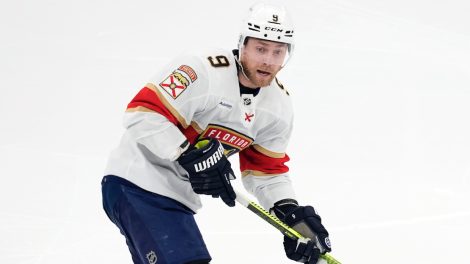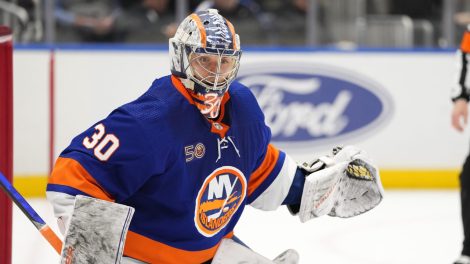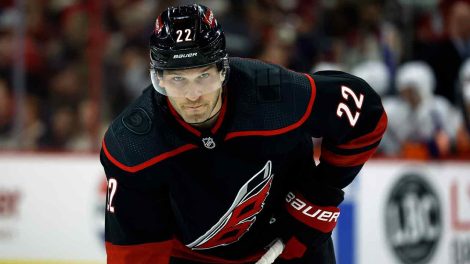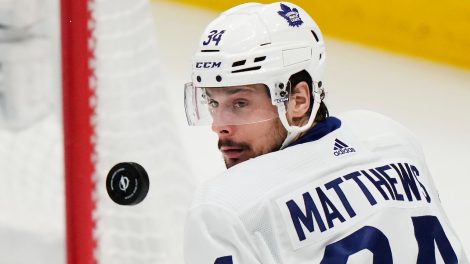There’s one trait that’s always trotted out as a key component of any truly elite NHL star’s skill set: hockey IQ. That supreme understanding that allows the game’s best to supplement their technical skill with dazzling creativity that sets them a cut above the rest.
It’s that type of top-level on-ice intelligence that allows a player to transition seamlessly between positions. Shifting from the wing to centre ice, or vice versa, might not seem like a significant change, but that slight move brings a whole host of altered responsibilities in both ends of the rink.
A few of the NHL’s premier stars have undergone this position switch this season, leading to a quick resurgence from some and a prolonged period of adjustment from others. That being the case, let’s take a look at who’s thriving and who’s falling short:
1. Claude Giroux, Philadelphia Flyers
It’s not often you see a club’s captain, top-line centre, and face of the franchise shoved over to the wing, but that’s exactly what transpired in Philadelphia. However, head coach Dave Hakstol said his decision to move Giroux from centre ice to left wing was grounded in the potential for his captain to feed off of the extra space and get back to making high-end plays on the regular.
As it turns out, it was a brilliant move. Through 25 games, Giroux has been an absolute force for the orange and black, amassing 11 goals (just three shy of the total he posted all of last season) and 28 points through that span. That works out to a goals per game pace of 0.44, ranking as the highest of Giroux’s career and putting him on track for roughly 35 tallies by the year’s end. His points per game pace of 1.12 is his highest in half a decade, angling him towards a 90-point finish.
One key aspect of the positional change has to do with the rest of the Flyers’ personnel. Moving Giroux over allowed Sean Couturier to climb up into the No. 1 centreman role, with Jakub Voracek filling out the line on the right side. At the season’s quarter-mark, the trio has combined for the most even-strength goals (23) of any line in the league, according to Corsica, even besting the potent scoring trio in Tampa Bay.
2. Brayden Schenn, St. Louis Blues
Leaving the Flyers organization last summer via trade allowed Brayden Schenn to undergo a position swap of his own, as the 26-year-old was given the opportunity to return to centre ice with the St. Louis Blues after skating primarily as a winger in Philadelphia.
While Schenn and the Blues faithful had hope that the move would pay off, it’s fair to say few predicted as strong a showing as this.
Partnered with wingers Vladimir Tarasenko and Jaden Schwartz on the Blues’ top line, Schenn has emerged as a bona fide No. 1 centreman, posting 10 goals and 30 points through 25 games. He and his new mates all rank among the top 10 scorers in the league at the moment, having combined for the third-most even-strength goals (17) thus far. In terms of defensive responsibility, the Blues trio is in fact tied with Giroux’s line for tops in the league, boasting a goal differential of plus-13 after allowing just four goals-against when on the ice during 5-on-5 play.
Schenn’s goal-scoring pace (the highest of his career) has him on track to finally reach the 30-goal plateau after netting 25 and 26 over the past two seasons. On the assists front, he’s plotting new territory. The Saskatoon, Sask. native’s 1.20 points per game (also a career high pace) puts him in line for 98 points by the time the regular season closes out. Reaching that ceiling may seem a near impossibility, but topping his previous best of 59 points seems like a certainty.
3. Jonathan Drouin, Montreal Canadiens
It was a storybook homecoming for Jonathan Drouin, who got his wish to part ways with the Tampa Bay Lightning and in doing so was gifted a prime role in his hometown team’s offensive scheme. And a shift back to centre ice after playing as a winger with the Lightning.
While there’s no question Drouin has all the skill and hockey IQ required to dominate as the Canadiens’ top pivot, the switch hasn’t exactly been easy goings so far. Perhaps that’s a symptom of Montreal’s larger problems, as the team has gotten off to a far rockier start than anyone could have predicted.
Drouin hasn’t been a complete letdown, still with five goals and 17 points through 25 games, but the move to Montreal, and to centre, has brought a slight decrease to both his goals per game pace (0.29 last season, 0.20 this season) and points per game pace (0.73 last season, 0.68 this season).
Given the strong performances that have been dotted throughout his short tenure in Canadiens colours thus far, and the fact that the drop-off has been minimal, it’s far too early to assess Drouin’s true value as a centreman. Also complicating matters is that he’s currently sporting a shooting percentage of 7.8 per cent, well below the 11.5 per cent he posted last season. And yet, he’s shooting at roughly the same rate (2.56 shots per game this season vs. 2.51 last season), meaning the 22-year-old might be due for a turnaround.
If there’s one star having a tough time dealing with his new on-ice surroundings, it’s veteran centreman-turned-winger Jason Spezza.
The longtime Ottawa Senator and current Dallas Star was pushed to the outskirts of the offensive zone this season after making his name as one of the premier pivots in the sport for the majority of his career. And so far, the results haven’t been pretty.
With 25 games in the books, Spezza has just three goals and nine points to his name. That translates to the worst goals per game and points per game pace of his career, putting him on a path towards a 10-goal, 30-point season. That might not seem too bad for a 34-year-old player in a depth role, but it would surely be a significant step back for Spezza, who’s never finished with fewer than 50 points in a full season.
This isn’t necessarily an issue of age sapping up the Toronto native’s formerly elite skill. Last season, at age 33, he managed to post 50 points in just 68 games—a 60-point effort when translated to a full 82 games. But it’s not all on Spezza, or the position change. The veteran has also seen his ice-time cut by three minutes, down to an average of 13:13 per game (his lowest average since he was a fresh-faced rookie), throwing a key obstacle in his path to consistent production.
Spezza has been open about the challenges of switching roles so late in his career. “Things change. You have to adapt. I’m trying feel comfortable being uncomfortable,” he told SportsDay’s Mike Heika recently, adding that having assistant coach Stu Barnes in the mix greatly helps. “It’s a big deal, and him being an ex-player who is recently removed from the game, that helps a great deal. A lot of the challenge for me is moving from centre to wing and Stu did that, so it helps.”
[snippet id=3317857]
5. Patrick Marleau, Toronto Maple Leafs
It wasn’t a permanent shift, but veteran winger Patrick Marleau was forced to dabble in some positional musical chairs this season as well, as head coach Mike Babcock has relied on Marleau’s prowess at centre for a key chunk of games this season.
Marleau’s role in the Leafs’ 2017-18 lineup has been in flux as he’s emerged as a versatile piece for Babcock, but in the 11 games wherein the part time winger, part time centre has taken at least five faceoffs (i.e. played primarily as a centreman), he’s posted a combined three goals and six points.
That reliability at the dot, despite playing the majority of his career in San Jose on the wing, is a key reason the Leafs’ head coach keeps moving Marelau to the middle—particularly on the road.
“I don’t control the matchups, so I can’t get mismatched in any situation with (Marleau) at centre,” Babcock told Sportsnet’s Chris Johnston last month. “I don’t know if he’d score as much if he played in the middle all the time,” said Babcock. “And I want him to score and be putting the heat on defences because you’re behind the play and coming up later, he’s not as (active) on the forecheck.
“His speed is so good you’d like to use that. So that’s the negative side.”
[relatedlinks]









